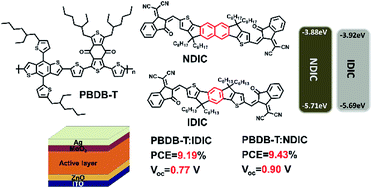Nonfullerene acceptors comprising a naphthalene core for high efficiency organic solar cells†
Abstract
A fused-ring electron acceptor (FREA) NDIC is designed and synthesized. Inspired by IDIC, NDIC was constructed by replacing the benzene with a naphthalene ring in its core unit. IDIC exhibits an optical bandgap of 1.60 eV and a lower lowest unoccupied molecular orbital (LUMO) energy level of −3.92 eV. In comparison, NDIC displays an optical band gap of 1.72 eV and a higher lying LUMO energy level of −3.88 eV. Due to the higher energy level, inverted devices based on NDIC exhibit a higher open circuit voltage (Voc) of 0.90 V, which is much higher than that of IDIC (0.77 V). After a series of optimizations, a power conversion efficiency (PCE) of 9.43% was obtained with a PBDB-T:NDIC blend active layer, in comparison, a PCE of 9.19% was achieved based on IDIC. Our results demonstrate that a tiny variation in the molecular structure could dramatically affect the optical and electrochemical properties, and thus the photovoltaic performance.



 Please wait while we load your content...
Please wait while we load your content...